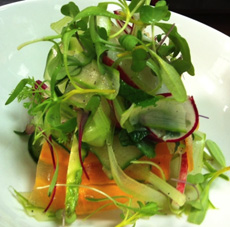TIP OF THE DAY: Salad Without Lettuce
|
In America, “salad” has come to mean a mixture of lettuce and possibly some other raw vegetables, generally including tomato for color, regardless of the seasonality or flavor. But that’s not the origin of the word.
The word comes from the Latin salata, short for herba salata, salted vegetables, a popular Roman dish. The vegetables were seasoned with brine; vegetables that sat in salted water for an hour or more become pickled vegetables. Over the centuries, salad became a cold dish of vegetables and a dressing, sometimes with a protein: beef, chicken, eggs, seafood, etc. Today we have: |
 Microgreens, radishes and aspic with carrots. Photo courtesy Silk Rd Tavern. |
|
|
Lettuce-Free Salads Instead, use arugula, baby spinach, carrots, celeriac (celery root), celery, cucumber, endive, fennel, green beans, microgreens, mushrooms, mustard greens, radicchio, radishes, sprouts, summer squash, watercress and things you come across in the produce section that you haven’t tried before in a salad. Integrate some color: beets, carrots, cherry tomatoes. You can still use favorite garnishes: croutons, herbs, nuts, seeds. If you like to have fun with gelatin, make an aspic with vegetables as shown in the photo, and serve it with salad on the side or on top. What About The Dressing? You already know this, but fatty dressings based on mayonnaise, sour cream. Stick with vinaigrettes made with a heart healthy oil (avocado, canola/rapeseed, flaxseed, olive, sesame, walnut). |
||


